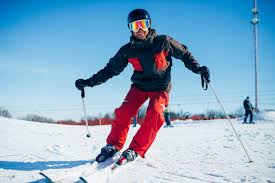Essential Skills and Safety Tips For Winter Sports Lifeguarding

One of the most important responsibilities needing particular talents and knowledge is winter sports lifeguarding. For lifeguards working in icy settings and cold temperatures, challenges particular to these locations arise. Well-prepared lifeguards help to guarantee the safety of every visitor and athlete. The main elements of winter sports lifeguarding—including equipment, safety precautions, and training—are addressed in this piece.
What is Winter Sports Lifeguarding
Winter sports lifeguard is protecting people at areas like ice rinks, ski resorts, and snowboarding parks. These locations present dangers distinct from those of conventional swimming pools or beaches. Chance of collisions rises in cold conditions and slippery ice. Lifeguards have to be prepared to promptly answer to hypothermia, falls, or other accidents.
Significance of specialized education
Regular lifeguard skills are essential but not enough for wintry sports settings. Winter sports lifeguard training covers cold damage awareness, ice rescue methods, and equipment management in extreme weather. Many looking for lifeguard classes close to me want to find courses that cover these specific abilities. This training guarantees lifeguards are capable of managing winter-unique events.
Common Dangers in Winter Sport Destinations
Winter sports have their own hazards. Common risks lifeguards encounter are some of the following:
- Slips and falls brought on by ice and snow
- Hypothermia and frostbite caused by cold exposure
- Collisions among ice skaters, skiers, snowboarders
- In icy water at outdoor winter swim locations, drowning
- From equipment like skis, poles, and snowboards come injuries.
Lifeguards should be continually aware of locations where these events occur most often.
Important equipment for winter lifeguards
Winter sports lifeguards need unique equipment to work safely and effectively:
- Warm and weatherproof boots and uniforms
- -Ice pick or spike for ice rescue
- Thermal gloves keep hands working in cold.
- Radios for quick communication in large, dispersed regions
- Sleds meant for snowy and rough ground
Good equipment enables lifeguards to execute rescues more quickly and shields them from falling victim themselves.
Winter Emergency Rescue Techniques
Winter sports lifeguarding rescue techniques are distinct from those used in swimming pool rescues.
- Ice rescue: Approaching victims without cracking thin ice
- Moving hurt skiers or snowboarders off hills securely.
- Carrying injured people using sleds and ropes
- Giving initial aid for fractures and hypothermia
These rescue techniques help to fully prepare lifeguards for winter activities in training programs.
Developing Mental and Physical Toughness
Cold weather lifeguarding is challenging. Long hours in the cold call for endurance, as does the capacity to stay cool under crisis. Frequent physical exercise builds strength and endurance. Focusing on mental readiness helps you to act decisively when time is of utmost urgency as well.
Winter lifeguard communication abilities
Good communication is absolutely essential. Winter sports venues are often busy and loud. To communicate with emergency responders and each other, lifeguards use radios and hand signals. Moreover, they offer advice to the public to avoid mishaps. When lifeguards work well together, everyone present’s safety is increased.
Locating Proper Lifeguard Certification
Anyone interested in winter sports lifeguarding should look for reputable certifications. These classes offer information on cold temperatures, rescue techniques, and safety guidelines. Many people seek online for lifeguard certification or winter safety-focused training. Selecting a course stressing winter circumstances is crucial for career success.
Legal obligations and Ethics
Lifeguards should exercise care for all winter sports participants. They have to follow procedures and act responsibly at all times. Ignoring safety guidelines or postponing reaction might have severe repercussions. Above all else in every situation, ethics in lifeguarding means giving life and health the priority.
Various Winter Sports Venues
Several winter surroundings call for lifeguards:
- Indoor ice skating areas
- Designated swimming areas on outdoor frozen lakes
- Snow parks and ski resorts
- Winter swimming competitions
Every situation has particular precautions and regulations. Depending on the place and kind of activity, lifeguards adjust their abilities.
Winter Challenges of Lifeguarding
Working as a lifeguard can be quite difficult given the cold and variations in weather. Poor visibility brought on by snow, slick ground, and wind chill is a frequent problem. Equipment could freeze or fail. As the weather conditions vary rapidly, lifeguards must remain flexible and willing to change their approach.
Significance of Cooperation
There is no lone lifeguard working. Good winter sports lifeguarding depends so much on teamwork. Along with hotel staff, medical teams, and other safety personnel, lifeguards collaborate. Every so often they work on drills together. This partnership helps to maintain everyone safe and speeds up emergency response times.
Choosing Between Local Lifeguard courses
Knowing what to look for makes choosing the right class simpler. A decent winter sports lifeguard course will present:
- Hands-on chilly circumstances instruction
- Ice and snow rescue courses
- Accreditation acknowledged by professional organizations
- Experienced teachers with winter lifeguard history
These qualities ready lifeguards for genuine winter disasters.
Professional possibilities in winter sports lifeguarding
Good summer and winter seasonal work is provided by winter sports lifeguarding. Trained lifeguards are necessary all year-round at outdoor activity centers, resorts, and rinks. Lifeguard certification opens doors to Positions in emergency reaction, coaching, and safety management. Many professionals like the active lifestyle and collaborative work involved.
Winter Lifeguard training: Keeping Current
Technology and lifeguard methods change over time. Through periodic refresher courses, lifeguards ought to keep their abilities current. Understanding new cold-weather equipment, rescue techniques, and medical cures improves safety results. Success in winter sports lifeguarding depends on ongoing training.
Final Word: The Role of the Lifeguard in Winter Safety
Special commitment and abilities are needed in winter sports lifeguarding. Under demanding and erratic circumstances, lifeguards save lives. To save lives, they mix physical capacity, specialized training, and quick thought. For individuals considering this profession, it is crucial to obtain accepted lifeguard accreditation and seek “lifeguard courses near me” especially emphasizing winter safety. To help lifeguards in their vital work, the American Lifeguard Association offers outstanding resources and certification programs.



